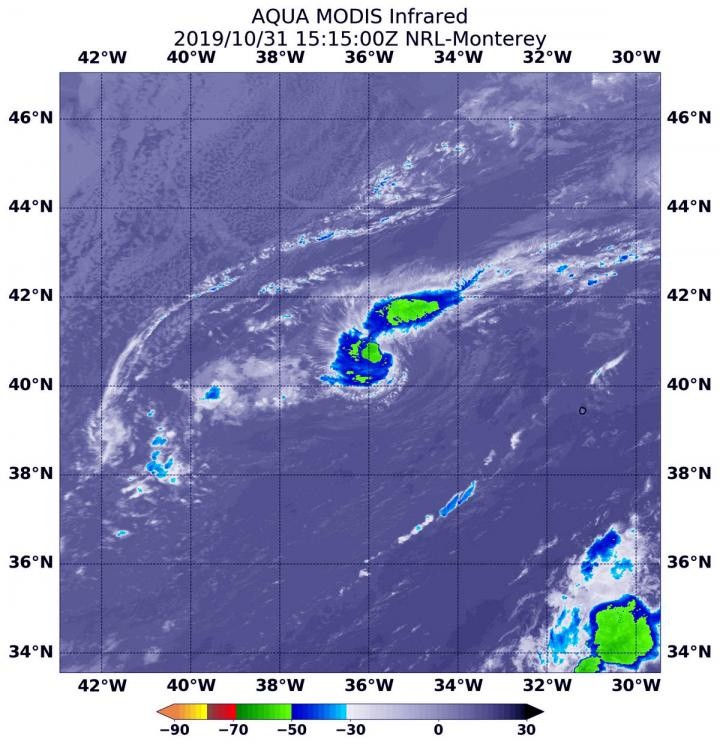
The latest addition to the Atlantic Ocean hurricane season developed quickly. NASA's Aqua satellite passed over the eastern North Atlantic Ocean on Halloween and provided forecasters with an infrared view of Subtropical Storm Rebekah.
Infrared data provides temperature information, and the strongest thunderstorms that reach high into the atmosphere have the coldest cloud top temperatures.
NASA's Aqua satellite passed over Rebekah on Oct. 31, 2019 at 11:15 a.m. EDT (1515 UTC) and measured the cloud top temperatures. The strongest storms with coldest cloud tops were as cold as or colder than minus 50 degrees Fahrenheit (minus 45.5 Celsius) around the center of circulation in a band of thunderstorms wrapping into the center from the northeastern quadrant.
What is a Subtropical Storm?
Rebekah developed on Halloween eve, Oct. 30, by 5 p.m. EDT as a subtropical storm. NOAA's National Hurricane Center defines subtropical storms as "A non-frontal low-pressure system that has characteristics of both tropical and extratropical cyclones. Like tropical cyclones, they are non-frontal, synoptic-scale cyclones that originate over tropical or subtropical waters, and have a closed surface wind circulation about a well-defined center. In addition, they have organized moderate to deep convection, but lack a central dense overcast. Unlike tropical cyclones, subtropical cyclones derive a significant proportion of their energy from baroclinic sources, and are generally cold-core in the upper troposphere, often being associated with an upper-level low or trough. In comparison to tropical cyclones, these systems generally have a radius of maximum winds occurring relatively far from the center (usually greater than 60 nautical miles), and generally have a less symmetric wind field and distribution of convection.
Rebekah's Halloween Status
At 11 a.m. EDT (1500 UTC), the NHC or National Hurricane Center reported that the center of Subtropical Storm Rebekah was located near latitude 40.7 degrees north, longitude 35.3 west. The storm is moving toward the east-northeast near 18 mph (30 kph). An eastward turn with some increase in forward speed is anticipated by early Friday. Maximum sustained winds remain near 45 mph (75 kph) with higher gusts. Winds of 40 mph extend outward up to 70 miles (110 km) from the center. The estimated minimum central pressure is 990 millibars.
The storm should weaken and become a post-tropical cyclone by this evening or early tomorrow, Nov. 1.
What is a Post-tropical Cyclone?
NHC defines a post-tropical cyclone as a former tropical cyclone. This generic term describes a cyclone that no longer possesses sufficient tropical characteristics to be considered a tropical cyclone. Post-tropical cyclones can continue carrying heavy rains and producing high winds. Note that former tropical cyclones that have become fully extratropical as well as remnant lows are two classes of post-tropical cyclones.
Hurricanes are the most powerful weather event on Earth. NASA's expertise in space and scientific exploration contributes to essential services provided to the American people by other federal agencies, such as hurricane weather forecasting.
© 2025 NatureWorldNews.com All rights reserved. Do not reproduce without permission.





